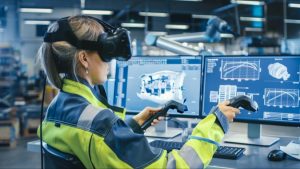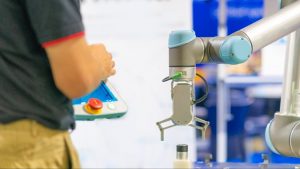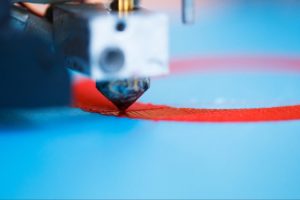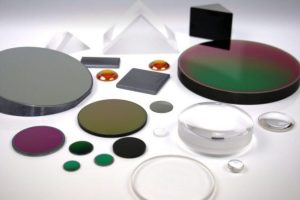Navigating the Shift: Industry 4.0 vs. Industry 5.0 – Welcoming the Next Wave of Innovation
10th Oct 2023Expanding on the foundational principles of the fourth industrial revolution, Industry 5.0 places a huge emphasis on fostering a flawless connection between machinery and humans. It harnesses the innate creative spirit of human beings and combines it with the remarkable proficiency of modern technologies, seamlessly fusing the best of both realms.

Outfitted with sensors, AI, and sophisticated monitoring systems, Industry 5.0 is set to attain unprecedented performance levels and spur further advancement. At Knight Optical, we have a rich history of contributing to some of the most high-performing Industry 4.0 devices. As we eagerly await developments, we probe more deeply into Industry 5.0, exploring the numerous gains and transformative power of adopting the shift.
 When you think of automation – featuring contemporary robots and AI – within a production setting, our thoughts often gravitate toward the automobile manufacturing arena. Perhaps it’s the industry’s intrinsic commitment to visionary ideals or the compelling narrative woven into their advertising campaigns, likening their pioneering assembly methods to the originality discovered in their vehicles. And, indeed, this perception holds true. The automotive sector embraced the winds of change, specifically with the advent of Industry 4.0, resulting in more streamlined construction lines and heightened safety protocols.
When you think of automation – featuring contemporary robots and AI – within a production setting, our thoughts often gravitate toward the automobile manufacturing arena. Perhaps it’s the industry’s intrinsic commitment to visionary ideals or the compelling narrative woven into their advertising campaigns, likening their pioneering assembly methods to the originality discovered in their vehicles. And, indeed, this perception holds true. The automotive sector embraced the winds of change, specifically with the advent of Industry 4.0, resulting in more streamlined construction lines and heightened safety protocols.
However, it’s essential to acknowledge that not all sectors move at the same pace. Take, for instance, the pharmaceutical sector, which was somewhat more measured in its response to the digital revolution. Consequently, it found itself trailing behind, only beginning to grasp the perks of embracing digitalisation now. Confronting this issue, Amr van den Adel, PhD, a Researcher at Auckland University of Technology in New Zealand – who recently authored a paper on the subject – emphasised the need for the drug industry to anticipate Industry 5.0 and contemplate the future work dynamics within digitised facilities. He discussed this topic in an interview with Genetic Engineering & Biotechnology News [1].
Cogs and Cognition: Inside the Mind of Industry 5.0
Rather than being seen as a natural progression from Industry 4.0, Industry 5.0 is primarily centred around the idea of machines and humans working together in harmony. An Editor’s Note in a recent write-up by Automation World highlights the demand for the industry to familiarise itself with this terminology and understand that Industry 5.0 should be viewed as an integral aspect of Industry 4.0 [2].

In addition to the concept of blending human creativity with efficiency through technology, Industry 5.0 also addresses the challenge of eliminating human participation while utilising tech like AI, the Internet of Things (IoT) and big data analytics.
Benefits of Industry 5.0
One great advantage offered by Industry 5.0 lies in its capacity for learning and automation, bringing forth not only more dependable procedures but also safer ones. This brings perks to a number of sectors, presenting all-important benefits such as less downtime, thanks to tools like the following:
AI algorithms:
AI models play a key role in Industry 5.0. They are crucial in optimising fabrication operations, leading to enhanced resourcefulness, waste reduction, and financial savings. AI, through image recognition and machine learning, significantly enhances quality control. Furthermore, they can predict equipment or machinery failures by analysing historical statistics and current conditions, mitigating costly non-operational risks. In addition, notably, AI-powered monitoring systems excel in swiftly detecting risk factors and taking preventive measures to avert accidents.
Virtual Reality/Augmented Reality (VR/AR):
 VR and AR represent a perfect collaboration between technology and human capabilities, and their prospect is immense within the branch of Industry 5.0. They can deliver real-world training incidents for newly recruited employees, offering practical scenarios instead of traditional classroom-style instruction. Additionally, they allow for the creation of detailed 3D virtual models for design and prototyping purposes, opening up limitless possibilities. Moreover, AR-equipped devices like smart glasses permit workers to access guidance, instructions, and visual overlays of information, which is particularly beneficial for addressing intricate tasks and troubleshooting challenges.
VR and AR represent a perfect collaboration between technology and human capabilities, and their prospect is immense within the branch of Industry 5.0. They can deliver real-world training incidents for newly recruited employees, offering practical scenarios instead of traditional classroom-style instruction. Additionally, they allow for the creation of detailed 3D virtual models for design and prototyping purposes, opening up limitless possibilities. Moreover, AR-equipped devices like smart glasses permit workers to access guidance, instructions, and visual overlays of information, which is particularly beneficial for addressing intricate tasks and troubleshooting challenges.
Advanced Robotics & Cobots:
 Collaborative robots, otherwise referred to as cobots, the core focus of Industry 5.0, are primed to revolutionise interactions between humans and machines in industrial settings. These cobots facilitate seamless cooperation, granting a multitude of advantages, including agility, flexibility, and, most importantly, protection. Equipped with an array of sensors, such as infrared (IR) sensors, force/torque sensors, and vision sensors (cameras), they are engineered to detect different cues from their surroundings. They can identify heat emitted from the human body, notice fluctuations in force and torque, and visually spot both humans and objects within their workspace. This comprehensive sensing capability ensures a secure and harmonious work setting where both can collaborate with confidence.
Collaborative robots, otherwise referred to as cobots, the core focus of Industry 5.0, are primed to revolutionise interactions between humans and machines in industrial settings. These cobots facilitate seamless cooperation, granting a multitude of advantages, including agility, flexibility, and, most importantly, protection. Equipped with an array of sensors, such as infrared (IR) sensors, force/torque sensors, and vision sensors (cameras), they are engineered to detect different cues from their surroundings. They can identify heat emitted from the human body, notice fluctuations in force and torque, and visually spot both humans and objects within their workspace. This comprehensive sensing capability ensures a secure and harmonious work setting where both can collaborate with confidence.
3D Printing & Additive Manufacturing:
 3D printing has made a considerable impact across diverse divisions, from rapidly constructing houses on building sites to producing meat-substitute steaks for restaurants in London. Unsurprisingly, it carries huge potential in the domain of Industry 5.0. While it initially gained traction in smaller-scale functions, 3D printing is now positioned for substantial growth in the industrial sector.
3D printing has made a considerable impact across diverse divisions, from rapidly constructing houses on building sites to producing meat-substitute steaks for restaurants in London. Unsurprisingly, it carries huge potential in the domain of Industry 5.0. While it initially gained traction in smaller-scale functions, 3D printing is now positioned for substantial growth in the industrial sector.
To illustrate its capability, consider a recent development in September 2023 when the European Space Agency (ESA) invested in two 3D printing companies as part of its in-orbit manufacturing accelerator programme [3]. This investment reflects the growing belief that in-space manufacturing could offer a cost-effective alternative to transporting cargo into space, especially given the soaring costs associated with space launches.
Exoskeletons and AI:
While visions of futuristic contraptions reminiscent of the Blockbuster hit ‘Avatar’ may spring to mind, it’s worth noting that exoskeletons hold a key position in the context of Industry 5.0.
In fresh news, Infineon Technologies, a prominent semiconductor manufacturing company, is embarking on an ambitious scheme launching in October 2023. The €70m initiative, known as AIMS5.0 (Artificial Intelligence in Manufacturing Leading to Sustainability and Industry 5.0), is dedicated to cutting-edge hardware and software-based AI. This next-generation AI is designed to optimise resource consumption within manufacturing processes while simultaneously elevating product quality. Notably, this encompasses the application of machine learning in semiconductor manufacturing and the integration of hardware interfaces that enable direct control of exoskeletons by the human brain [4].

Seeing the Future Clearly
In the realm of Industry 5.0, where machines and humans work harmoniously to redefine productivity, optical components serve a critical purpose in enhancing various hardware innovations. Precision Lenses, Windows, Filters, Prisms and Beamsplitters, for example, are imperative for applications such as trailblazing robotics, vision-guided quality assurance, and immersive virtual reality simulations.
 At Knight Optical, we recognise the importance of optics in enabling these technological advancements. With our expertise in delivering premium optical solutions, we are positioned and prepared to supply optics that contribute to the success of Industry 5.0 breakthroughs.
At Knight Optical, we recognise the importance of optics in enabling these technological advancements. With our expertise in delivering premium optical solutions, we are positioned and prepared to supply optics that contribute to the success of Industry 5.0 breakthroughs.
As the landscape of industry continues to evolve, we remain committed to supporting the needs of forward-thinking industries, ensuring they have the optical clarity required to see the future clearly.
FOOTNOTES:
[1] https://www.genengnews.com/topics/bioprocessing/get-ready-for-industry-5-0/
[3] https://www.verdict.co.uk/3d-printing-space-manufacturing/